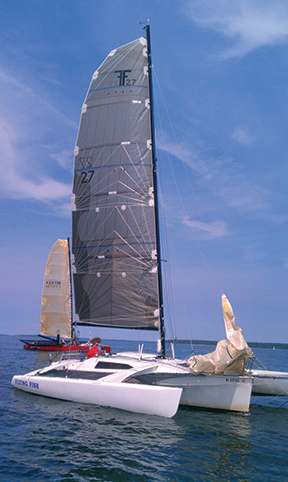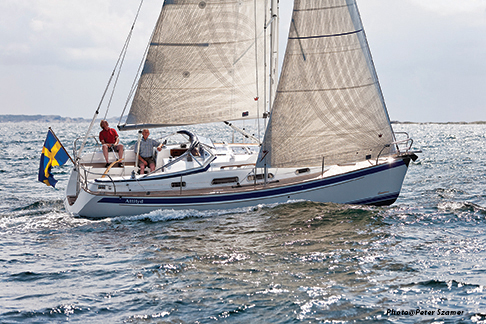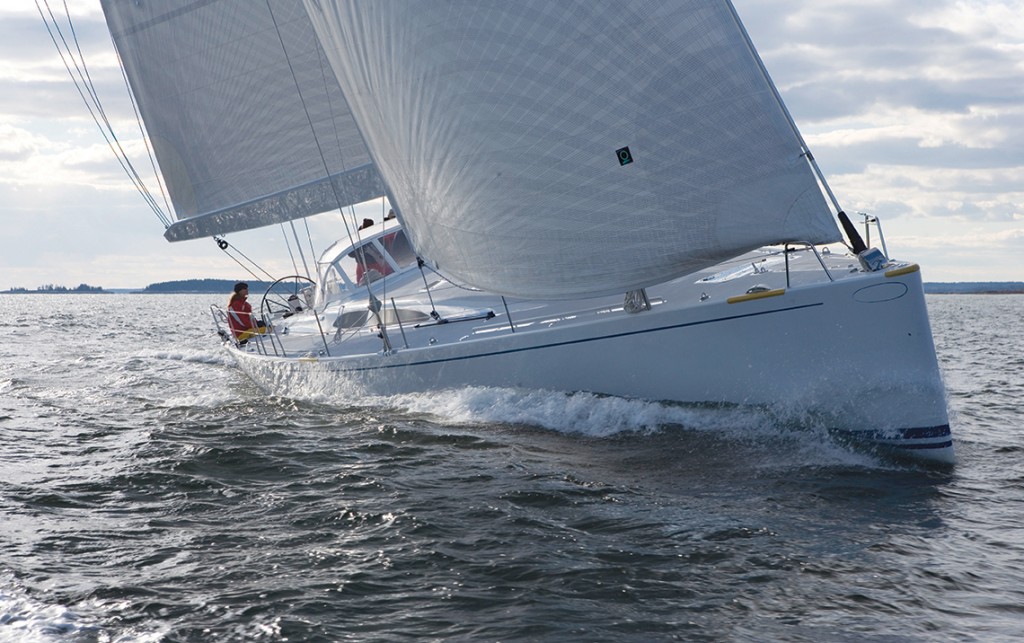Upgrading to laminated, composite sails will improve your boat’s performance for years to come…and will be more fun to use (published June 2013)
Ask any cruising sailor what he wants in a new sail and durability and reliability will inevitably be the first things mentioned. In fact, the next words might be some variation of the theme, “I’m not a racing sailor, I just cruise. I don’t care about performance.”
Actually, you do (or should), if you want to make sailing easier and more enjoyable. It’s just that “performance” for the cruising sailor is based on a different set of non-racing criteria that are just as important. It is not the quest for another tenth of a knot of boat speed or one degree of pointing.
BAGGY DOESN’T WORK
But it is vital to control heel if you want to maintain control of your boat. Full, stretchy sails, not only rob power in light air but, more critically, they create heel and weather helm as the breeze builds. If you are fighting your boat and struggling to keep her on her feet and going straight, you are suffering from sail shape issues.
Also, let’s face it, at some point, we all have to sail upwind and usually at the least convenient moments. After all, a bathtub with a sheet for a sail can go downwind. One of the real luxuries of a good cruising boat is the ability to go upwind when necessary and, for most, this goes against the grain of much of their design criteria. If sails are not shaped properly, and their materials and structures are not designed well enough to resist stretch, the boat will not be able to go upwind effectively.
Excessively stretched and baggy sails also affect the performance of the sail handling systems we rely on to make sailing easier; furling systems do not work as well and require increased effort; the potential for jamming in-mast and in-boom furling systems is greater; and, finally, we should keep in mind that on most cruising boats we have only one primary headsail that we ask to do the work of three, morphing from a powerful full-sized sail, to a flat heavy jib, through the miracle of partial furling. While there is no perfect solution for a roller furling headsail, the more you can control stretch the better the sail will work.
DURABILITY
So, the first thing we need to do is separate the measurement of sail durability into two parts. The first is from a structural standpoint, or, how long will it remain intact as a triangle? This is actually a fairly low bar and one well met by almost any modern synthetic sail material. The second half of the answer relates to sail shape. How long will the sail function as a critical airfoil, capable of driving the boat well and being effective upwind? This is the tougher part of the equation.
The shape-life of a sail is more problematic, since it deteriorates gradually with every hour of use and the gradual impact on performance is much harder to judge than that of a sail that simply won’t stay in one piece. Unfortunately, shape-life degrades more rapidly than structural life. Sails will be triangles long after they cease to resemble anything like a critical airfoil. Shape-life is very dependent on harshness of use, but good sail shape can only be expected for half to two-thirds of the structural life of a sail. How much deterioration you are willing to accept is largely a subjective matter.
The search for lower stretch is the Holy Grail for those who want better “shape-life” and better cruising performance. The less a sail deforms under load, the better it will work. Over the last 25 years this search has led to the gradual introduction of composite construction. Traditional woven construction (better known as Dacron), relies on tightly meshed very small polyester fibers, infused with resin and heat shrunk to pull it all together.

Composite construction, by contrast, has no limit on the size or type of fiber used. Larger fibers are better able to resist stretch and modern high modulus fibers like Carbon, Technora, Spectra and Vectran can have five-to-eight eight times the stretch resistance of Dacron for a given size.
Composites for cruising sails typically have exterior skins of woven polyester (taffetas) on either side to provide protection against chafe, impact and sunlight, but the guts consist of a matrix of relatively large fibers which do the work. Until relatively recently, most composites were pre-made in roll form, just like woven polyester, then cut into a jigsaw puzzle of triangles and trapezoids in an attempt to follow the primary load pattern.
This process is referred to as “tri-radial” construction and is still used in smaller and medium sized boats. Current generations of “membrane construction sails” no longer rely on pre-made rolls of material but, instead, entire sails are built on a custom basis as a single unified fiber matrix, apportioning fiber where and in whatever quantities the loads demand. The result is a nearly seamless, one-piece airfoil.
Composite sails are also more adaptable. With the ability to put fiber wherever it is needed, special cruising issues like the reef loads in a mainsail or the changing load pattern in a partially furled headsail can be specifically addressed.
The importance of using composite construction increases as a function of size. Loads on sails go up geometrically. To build a Dacron sail for a 100-foot boat might require two or three plies of woven material, and the sail would still stretch (and be incredibly heavy and hard to handle). The whole generation of superyachts over 80 feet would not exist today without composite sail construction. But even at 40 feet, the difference is dramatic, though polyester still might provide plenty of stretch strength, and high modulus fibers might not be justified. By 50 feet, it is case closed. No polyester construction can match the properties of a high modulus membrane sail.
LIFESPAN
How long do composite sails last? In terms of shape-life, they are dramatically better, deteriorating much more slowly than their woven polyester forebears. It is not a surprise today to look at a four or five year old membrane sail and barely be able to note any significant change in shape. Keep in mind that we were starting at a much higher level of performance/stretch resistance which makes the comparison between woven and composite even more uneven. A membrane sail built using polyester yarns will still stretch 30 to 50 percent less than Dacron. A high modulus Carbon/Technora sail will have four to five times the stretch resistance.
As a triangle, composites do well. Most sailmakers will still give the edge to woven sails but in the real world there is less and less to choose between them. Remember, composites have exterior skins of woven polyester. They are just not that different. The concern has always been will they delaminate? In the early years, this was definitely a problem. With time it has become less and less of an issue, particularly with the latest generation of sails that rely on “thermo-set” as opposed to “thermo-molded” adhesives and more sophisticated lamination techniques. If you are going to replace sails at the end of their shape life, as opposed to the end of their shape-life as a triangle, it is probably not going to be an issue.

So what do the extra dollars for composite construction buy you? In a word, control. When a puff hits, the boat will heel less, you will reef less often, your helm will be more balanced and you will be able to sheet in and go upwind without going sideways. When you add halyard tension or move a jib lead the sail will respond. Your furling systems will work better.
Ultimately, the sail shape will start better and stay better, and looking up at your sails will bring a smile to your face.
Dave Flynn, of Annapolis, Maryland, is the Special Projects Director for Quantum Sails. He has raced and won in many one-design, inshore and offshore events including Block Island Race Week, Key West Race Week, the Newport to Bermuda Race and the Annapolis to Newport Race.
HOW LONG DO SAILS LAST?
As a triangle, sails will last for a surprisingly long time. It is common to find sails still in use that are 10 to 15 years old. Structurally, they gradually lose their integrity over time, principally as the materials and stitching fail under the influence of the sun. UV causes woven polyester materials (referred to generically by the trade name Dacron) to gradually lose tear strength. If you can take an existing tear and easily extend it by pulling with moderate pressure, it’s over. You can fix the tear with a patch, but it will just keep on tearing in other places, often at the edge of any repair.
How long this process takes is obviously heavily influenced by how much sunlight and how strong the UV is to which they are exposed. Other factors come into play, including amount of breeze in which they are used, how much flogging, chafe and other abuse. Ultimately, a better way to think of the structural life of a sail is in terms of hours of use. A reasonably well-treated woven polyester sail that has been maintained regularly will last 3,500 to 4,000 hours. This means that if you are the average New England cruising sailor, who each year uses your boat two weekends each month of a five-month season, with an additional two full weeks of cruising thrown in, for a total of roughly 240 hours per year, your sails will last for 16 years! At the other extreme, live aboard your boat and cruise the Caribbean extensively and you might use your sails as much as 12 days per month (12 hours per day) all year round, for a rough average of 1,728 hours a year, and you will be replacing sails every 2.5 years. Do the math and you’ll get the idea.















